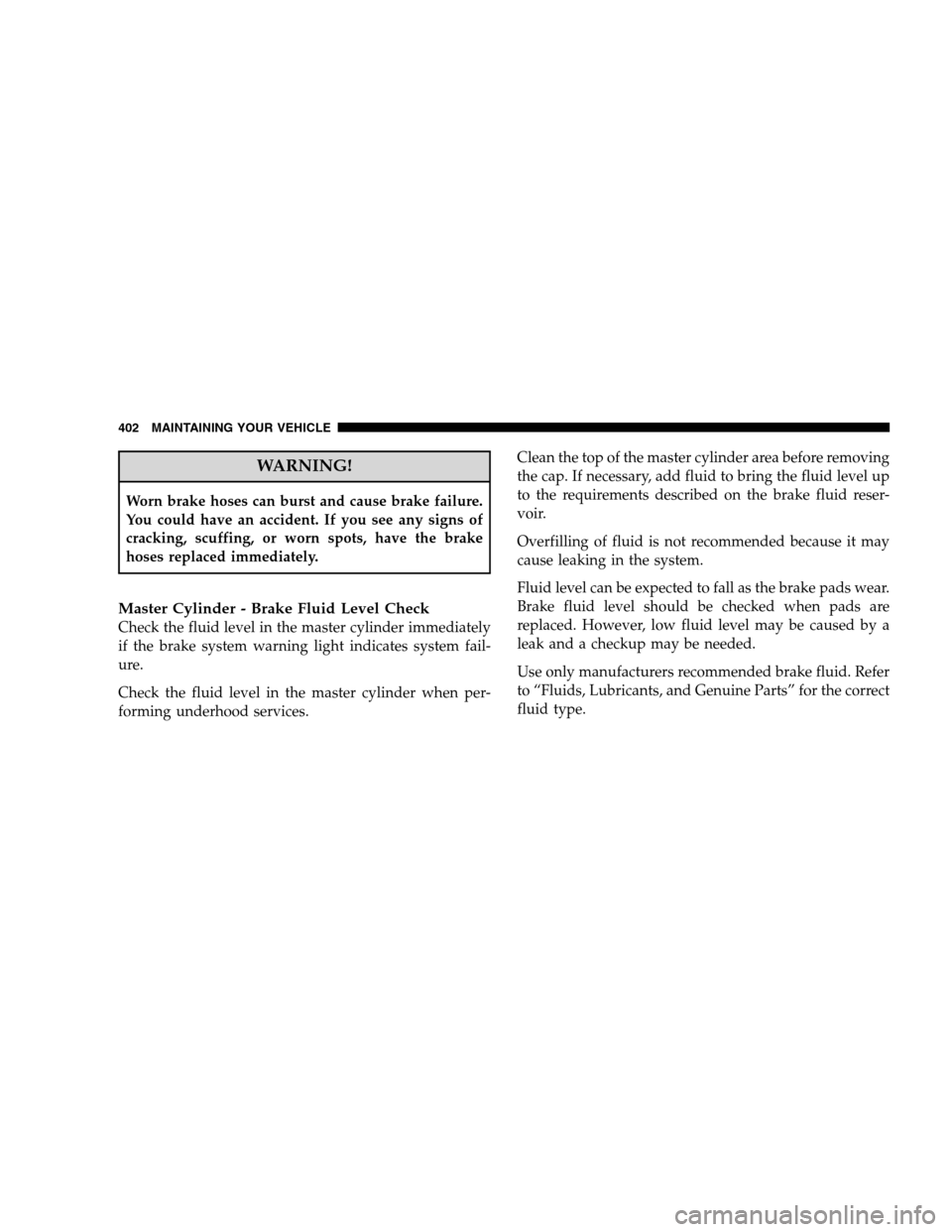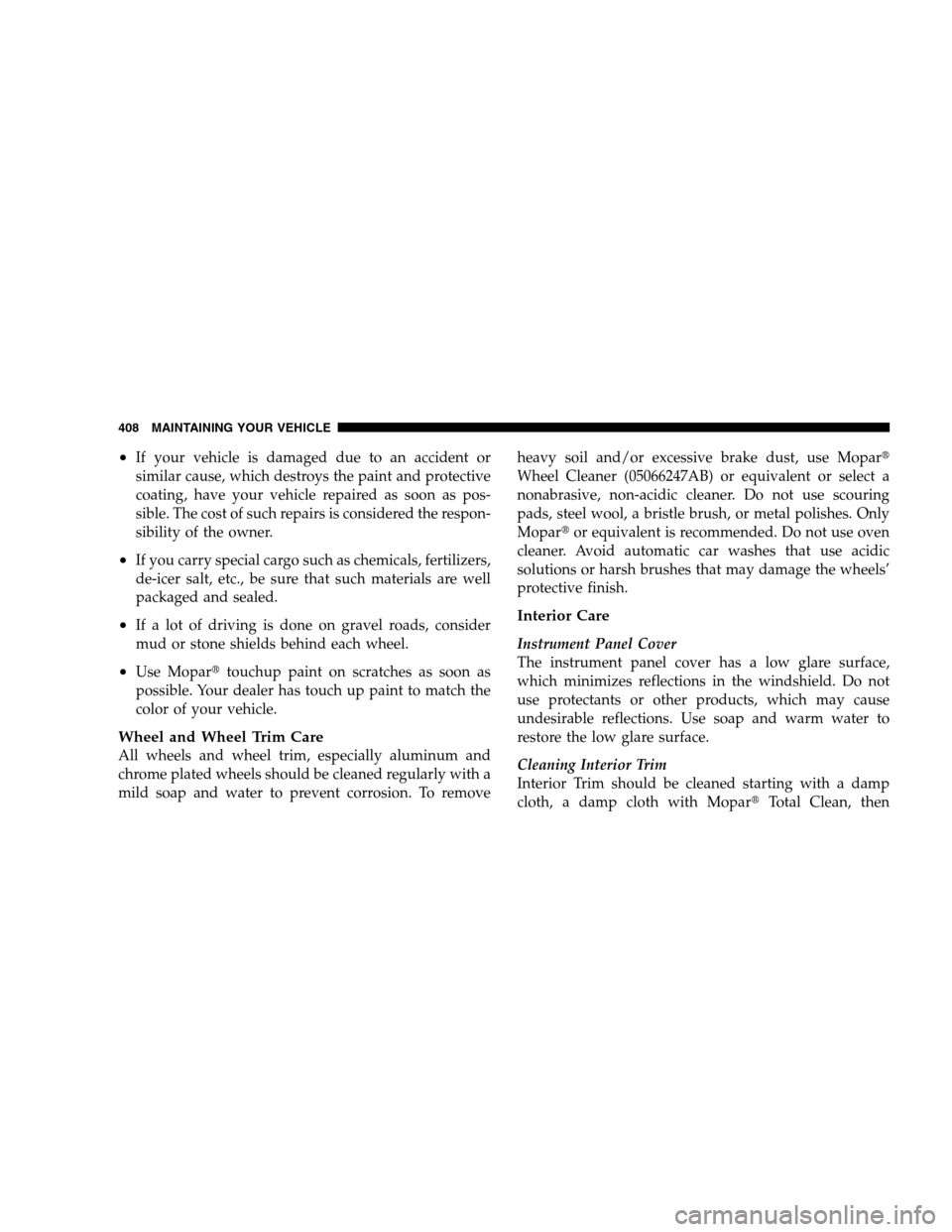Page 404 of 494

WARNING!
Worn brake hoses can burst and cause brake failure.
You could have an accident. If you see any signs of
cracking, scuffing, or worn spots, have the brake
hoses replaced immediately.
Master Cylinder - Brake Fluid Level Check
Check the fluid level in the master cylinder immediately
if the brake system warning light indicates system fail-
ure.
Check the fluid level in the master cylinder when per-
forming underhood services.Clean the top of the master cylinder area before removing
the cap. If necessary, add fluid to bring the fluid level up
to the requirements described on the brake fluid reser-
voir.
Overfilling of fluid is not recommended because it may
cause leaking in the system.
Fluid level can be expected to fall as the brake pads wear.
Brake fluid level should be checked when pads are
replaced. However, low fluid level may be caused by a
leak and a checkup may be needed.
Use only manufacturers recommended brake fluid. Refer
to “Fluids, Lubricants, and Genuine Parts” for the correct
fluid type.
402 MAINTAINING YOUR VEHICLE
Page 405 of 494

WARNING!
•Overfilling the brake fluid reservoir can result in
spilling brake fluid on hot engine parts and the
brake fluid catching fire.
•Use of a brake fluid that has a lower initial boiling
point than the recommended MOPAR�DOT 3
product or a brake fluid that is unidentified as to
FMVSS specification may result in sudden brake
failure during hard prolonged braking. You could
have an accident.
Use only brake fluid that has been in a tightly closed
container to avoid contamination from foreign matter or
moisture.
CAUTION!
Do not allow petroleum base fluid to contaminate the
brake fluid, all brake seal components could be
damaged causing partial or complete brake failure.
Automatic Transaxle
The automatic transaxle and differential assembly are
contained within a single housing.
The fluid level in the automatic transaxle should be
checked whenever the vehicle is serviced. Operation with
an improper fluid level will greatly reduce the life of the
transaxle and the fluid.
Fluid Level Check — Vehicles with 3.5L Engine
The automatic transaxle has no dipstick and is dealer
serviced only.
MAINTAINING YOUR VEHICLE 403
7
Page 406 of 494

Fluid Level Check — Vehicles with 2.4L and 2.7L
Engines
Use the following procedure to check the automatic
transaxle fluid level properly:
1. Park the vehicle on level ground.
2. Run the engine at curb idle speed for a minimum of 60
seconds.
3. Apply the parking brake fully.
4. Place the gear selector momentarily in each gear
position ending with the lever in “P” (Park).
5. Wipe the area around the dipstick clean to eliminate
the possibility of dirt entering the transaxle.
6. Remove the dipstick and determine if the fluid is hot
or cold. Hot fluid is approximately 180° F (82° C), which
is the normal operating temperature after the vehicle isdriven at least 15 miles (24 km). Hot fluid cannot be held
comfortably between the fingertips. Cold fluid is at a
temperature below 80°F (27°C).
7. Wipe the dipstick clean and reinsert until seated. Then,
remove dipstick and note the reading.
a. If the fluid is hot, the reading should be in the
crosshatched area marked “HOT” (between the upper
two holes in the dipstick).
b. If the fluid is cold, the fluid level should be between
the lower two holes in the area marked “COLD.”
If the fluid level is low, add sufficient fluid through the
filler (dipstick) tube to bring it to the proper level. Do not
overfill.
404 MAINTAINING YOUR VEHICLE
Page 410 of 494

•If your vehicle is damaged due to an accident or
similar cause, which destroys the paint and protective
coating, have your vehicle repaired as soon as pos-
sible. The cost of such repairs is considered the respon-
sibility of the owner.
•If you carry special cargo such as chemicals, fertilizers,
de-icer salt, etc., be sure that such materials are well
packaged and sealed.
•If a lot of driving is done on gravel roads, consider
mud or stone shields behind each wheel.
•Use Mopar�touchup paint on scratches as soon as
possible. Your dealer has touch up paint to match the
color of your vehicle.
Wheel and Wheel Trim Care
All wheels and wheel trim, especially aluminum and
chrome plated wheels should be cleaned regularly with a
mild soap and water to prevent corrosion. To removeheavy soil and/or excessive brake dust, use Mopar�
Wheel Cleaner (05066247AB) or equivalent or select a
nonabrasive, non-acidic cleaner. Do not use scouring
pads, steel wool, a bristle brush, or metal polishes. Only
Mopar�or equivalent is recommended. Do not use oven
cleaner. Avoid automatic car washes that use acidic
solutions or harsh brushes that may damage the wheels’
protective finish.
Interior Care
Instrument Panel Cover
The instrument panel cover has a low glare surface,
which minimizes reflections in the windshield. Do not
use protectants or other products, which may cause
undesirable reflections. Use soap and warm water to
restore the low glare surface.
Cleaning Interior Trim
Interior Trim should be cleaned starting with a damp
cloth, a damp cloth with Mopar�Total Clean, then
408 MAINTAINING YOUR VEHICLE
Page 415 of 494
CavityCartridge
FuseMini Fuse Description
3—10 Amp
RedBattery Feed — Center
High Mounted Stop
Light (CHMSL)/Brake
Switch
4—10 Amp
RedBattery Feed — Igni-
tion Switch
5—20 Amp
YellowTrailer Tow — If
Equipped
6—10 Amp
RedIgnition Off Draw
(IOD) — Power Mirror
Switch/Climate Con-
trols
7—30 Amp
GreenIgnition Off Draw
(IOD) Sense 1
8—30 Amp
GreenIgnition Off Draw
(IOD) Sense 2CavityCartridge
FuseMini Fuse Description
940 Amp
GreenBattery Feed — Power
Seats - if equipped/
PZEV Air Pump - if
equipped
10 —20 Amp
YellowBattery Feed — Cabin
Compartment Node
(CCN)
11 —15 Amp
Lt BlueSelectable Power Out-
let
12 —20 Amp
Yellow—
13 —20 Amp
Yellow—
MAINTAINING YOUR VEHICLE 413
7
Page 417 of 494
CavityCartridge
FuseMini Fuse Description
26 —15 Amp
Lt. BlueAuto Shutdown (ASD)
Relay Feed 2
27 —10 Amp
RedIgnition Run — Occu-
pant Classification
Module (OCM)/
Occupant Restraint
Controller (ORC)
28 —10 Amp
RedIgnition Run — Occu-
pant Classification
Module (OCM)/
Occupant Restraint
Controller (ORC)
29 — —Hot Car (No Fuse Re-
quired)
30 —20 Amp
YellowIgnition Run — Heated
Seats - If EquippedCavityCartridge
FuseMini Fuse Description
31 —10 Amp
Red—
3230 Amp
Pink—Auto Shutdown (ASD)
Relay Feed 1
33 —10 Amp
RedBattery Feed — Switch
Bank/Diagnostic Link
Connector/Powertrain
Control Module (PCM)
3430 Amp
Pink—Battery Feed — Anti-
Lock Brakes (ABS)
Module - if equipped/
Electronic Stability Pro-
gram (ESP) Module - If
Equipped
MAINTAINING YOUR VEHICLE 415
7
Page 418 of 494
CavityCartridge
FuseMini Fuse Description
3540 Amp
Green—Battery Feed — Anti-
Lock Brakes (ABS)
Module - If Equipped/
Electronic Stability Pro-
gram (ESP) Module - If
Equipped
3630 Amp
Pink—Battery Feed — Pas-
senger Door Module
(PDM)/Driver Door
Module (DDM)
37 —25 Amp
Clear—CAUTION!
•When installing the Totally Integrated Power
Module cover, it is important to ensure the cover is
properly positioned and fully latched. Failure to
do so may allow water to get into the Totally
Integrated Power Module, and possibly result in
an electrical system failure.
•When replacing a blown fuse, it is important to use
only a fuse having the correct amperage rating. The
use of a fuse with a rating other than indicated may
result in a dangerous electrical system overload. If a
properly rated fuse continues to blow, it indicates a
problem in the circuit that must be corrected.
416 MAINTAINING YOUR VEHICLE
Page 426 of 494
Tail/Stop Light, Rear Turn Signal Light, Backup
Light
The taillights are a two piece design. The turn signal,
brake and taillights are located in the rear corner body
panel housing. The back up and taillights are located in
the trunk lid housing.
Changing the Tail/Stop Light or Rear Turn Signal
Light
1. Open the trunk and gently pull back the trunk liner
behind the tail lamp
Split Taillight Assembly
Pull Back Trunk Liner
424 MAINTAINING YOUR VEHICLE